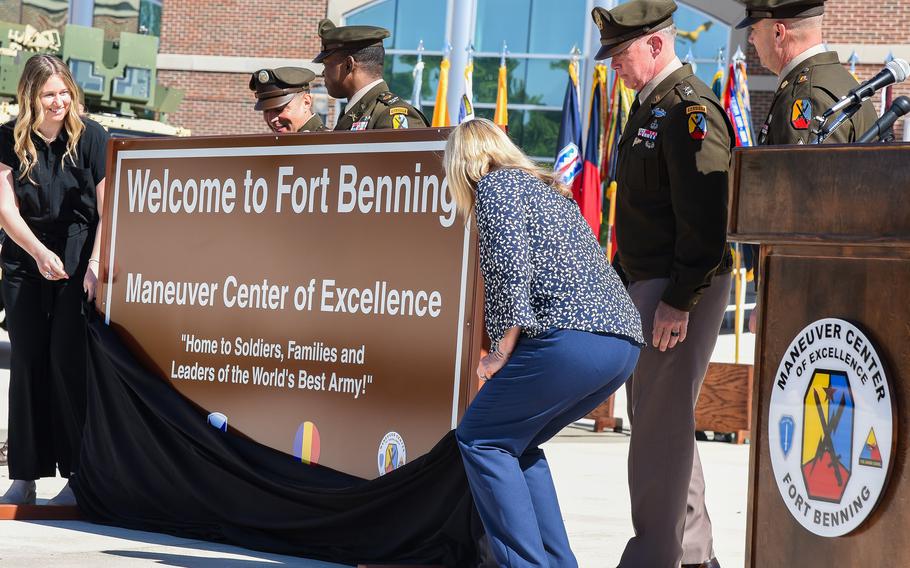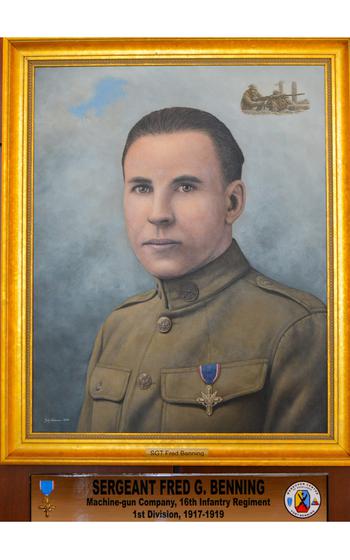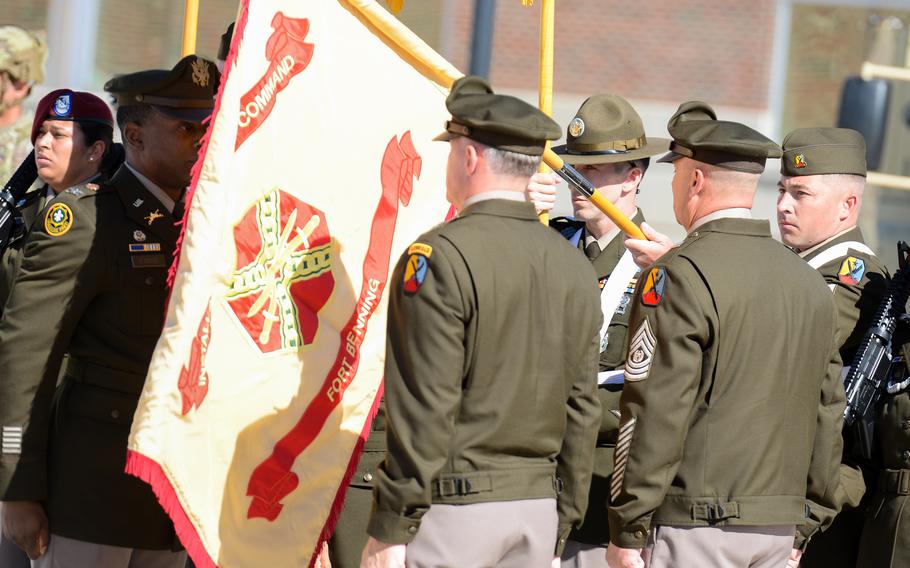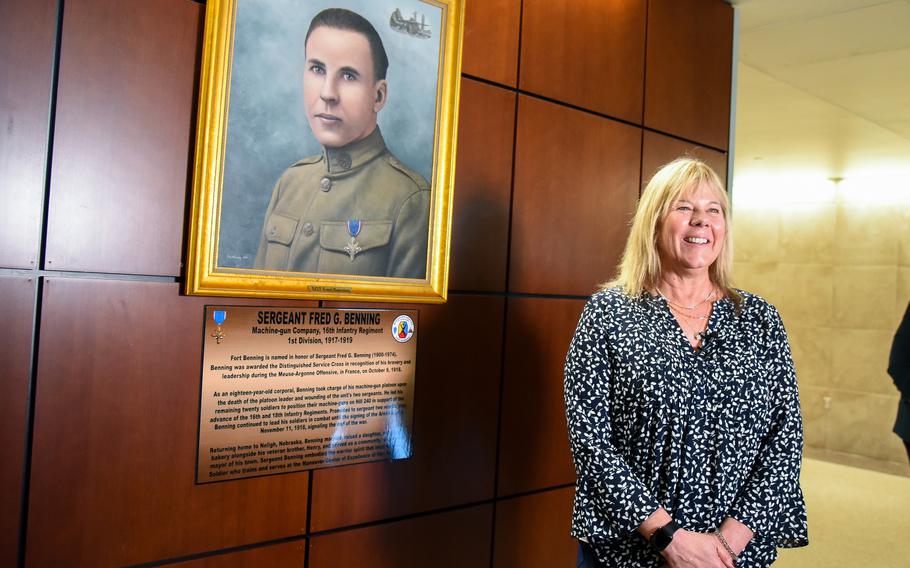
Danielle Proskovec, left, and her mother Sue Conger-Williams, the great-granddaughter and granddaughter of World War I Army Sgt. Fred Benning, help unveil a new base sign Wednesday, April 16, 2025, as officials gathered to mark the change of the former Fort Moore to Fort Benning. Once named for Confederate Gen. Henry Benning, the Georgia Army training post became Fort Moore in 2023, but Defense Secretary Pete Hegseth ordered it changed back to Fort Benning last month, this time in recognition of the World War I soldier. (Corey Dickstein/Stars and Stripes)
FORT BENNING, Ga. — Fred Benning was a humble, small-town man who rarely spoke of his exploits as a teenage soldier in Europe, where he earned the Army’s second highest honor for battlefield heroism during World War I, his granddaughter said Wednesday.
Most of what his family knew of his service was from artifacts that Benning discarded in old containers in his home in Neligh, Neb., Sue Conger-Williams, the granddaughter, said at the Georgia Army post now named for her late grandfather. Top Fort Benning officials gathered with Conger-Williams and her family to mark the change of the major training post from Fort Moore to Fort Benning — a name the installation held for decades in honor of a different Benning who had served the Confederacy.
“My grandpa, Fred G. Benning, was truly a special man,” Conger-Williams told a small crowd gathered just outside Fort Benning’s Maneuver Center of Excellence. “He was a man of integrity who knew the value of hard work. He lived a life of service, dedicating himself to his family, his country and his community. He loved helping people, and that’s how I will always remember him. He is my hero.”
Benning enlisted in the Army at 17 years old in 1917 within two weeks of the U.S. declaring war against Germany. Within months, he was sent to France to serve in the infantry. Within a year, Benning had risen to corporal and leading a machine gun team, said Army Maj. Gen. Colin Tuley, Fort Benning’s top commander.
On Oct. 19, 1918, as his platoon faced heavy fighting, Benning’s machine gun team was ordered to move to a strategic hill. The fighting cost the unit its commander and a string of additional casualties.

A painting of World War I Army Sgt. Fred Benning hangs inside Fort Benning’s Maneuver Center of Excellence. The Army on Wednesday, April 16, 2025, marked the change of the post’s name from Fort Moore to Fort Benning in Fred Benning’s honor. (Corey Dickstein/Stars and Stripes)
“After his platoon commander had been killed and two noncommissioned officers disabled, Cpl. Benning took command of the platoon, and by his leadership and by his courage, he conducted it through heavy fire to its assigned position on Hill 240,” his Distinguished Service Cross citation reads.
As the war wound down in the months after that battle, Benning was made a sergeant and stayed in Europe as part of the U.S. occupying force in Germany. In 1919, just 19 years old, Benning was honorably discharged from the service, and he returned to his Nebraska hometown where he opened a bakery with brother, Henry, who had also served in the Great War. In 1948, Benning was elected mayor of Neligh.
Conger-Williams said Wednesday that she had learned a great deal about her grandfather’s military service since it was revealed last month Fort Benning would bear his name. There were many aspects of his military service that meshed well with the man she knew, with whom she cherished fishing trips and backyard tea parties.
“My grandpa was always about integrity, doing the right thing when nobody’s looking, being the best person you can be,” she said. “I think he was always really focused on the importance of teamwork. I think he thought of his community as a team, like, this is the team I’m supporting. And I feel that was part of who he was as a soldier when he was completing his mission.”

Maj. Gen. Colin Tuley, the top general at Fort Benning, center, watches as the Fort Benning flag is raised Wednesday, April 16, 2025, as officials gathered to mark the change of the former Fort Moore to Fort Benning. The name now honors World War I Army Sgt. Fred Benning. (Corey Dickstein/Stars and Stripes)
Tuley said those values Benning encompassed should encourage the thousands of American soldiers who train every day on Fort Benning to aim to live up to the post’s new — and old — name.
The ceremony on Wednesday came less than two years after the short-lived name Fort Moore was bestowed on the 182,000-acre Army post, which is home to the service’s infantry and armor training programs, basic training units, the 75th Ranger Regiment headquarters, its 3rd Battalion and the 1st Security Forces Assistance Brigade. It is the home station to some 13,500 soldiers, and more than 25,000 additional troops train on the post every week, Fort Benning official said.
Defense Secretary Pete Hegseth on March 3 ordered the renaming of Fort Moore back to Fort Benning, honoring the World War I Benning instead of the installation’s original namesake, Confederate Gen. Henry Benning. A 2020 law barred Hegseth or other defense officials for naming military posts or other assets for those who served the Confederacy.
The Army officially implemented the change just hours after Hegseth’s order and began quickly replacing signs and other objects on the post reflecting the change in names.
The move came shortly after Hegseth ordered Fort Liberty, N.C., back to the name Fort Bragg in February in honor of another little-known Army hero, Pfc. Roland L. Bragg, whose lifesaving antics to escape custody of German forces during World War II’s Battle of the Bulge earned him a Silver Star.
Hegseth, a former Fox News anchor and Army National Guard infantry officer who served in Iraq and Afghanistan, has blasted the efforts to renamed Fort Bragg and Fort Benning and seven other Army posts as “woke” and damaging to the military’s intergenerational bonds between those who serve on the installations. The defense secretary has not announced further name changes for other Army posts, but defense officials have not ruled out such moves.
The name Fort Moore was chosen after a congressionally created panel studied for months the issue of ridding the U.S. military of honors for Confederate officials. It honored the late Lt. Gen. Hal Moore and his wife, Julia, a well-known and highly respected couple who had huge impacts on the Army and deep ties to Fort Benning. Both are buried in the post cemetery.
It was the only Army post named for a soldier and their spouse.
Hal Moore was a revered warrior who served in the Korean War and earned the Distinguished Service Cross in Vietnam for lifesaving heroics during the war’s first major battle before rising to a three-star general. His wife, Julia, meanwhile held their family together through more than two dozen moves and served as an activist for Army families. The daughter of an Army officer, she was a lifelong volunteer for the American Red Cross, and she is also credited with revamping the Pentagon’s casualty notification process to ensure such news was delivered by uniformed Army officers, after she witnessed families being notified of Vietnam casualties by telegrams delivered by taxi drivers.
The installation embraced the name Fort Moore as a reminder to take care of soldiers and their family members, adopting the phrases “Be Moore” and “Welcome Home” as installation sayings.
The Moores’ children have said they were disappointed by Hegseth’s decision to remove their parents’ name from the post, where they once lived and some of them later served.
“Renaming Fort Benning as Fort Moore created a unique opportunity to honor Army families, reinforce the warrior ethos and inspire generations of combat leaders,” said Dave Moore, the couple’s youngest child and a retired Army colonel who served in Panama, Iraq and Afghanistan. “The legacy of Hal and Julie Moore remains a powerful testament to moral character and selfless service, continuing to inspire all who lead, serve and support the United States Army.”
Tully, the installation’s top general, said he personally broke the news to the Moores, and he promised the post would continue to honor Hal and Julia Moore. The couple’s portrait will remain displayed prominently in the Maneuver Center of Excellence’s foyer, near a new portrait of Fred Benning.
“They are a part of the fabric of this installation,” the general said. “Whatever the name may be on an installation board, the Moores are an interwoven part of this installation. And that will never go away.”
The initial name-changing efforts cost taxpayers some $60 million, including about $830,000 to change signs and other items at Fort Benning. Officials at the post on Wednesday said they estimated the new change would cost about $653,000.

Sue Conger-Williams, the granddaughter of World War I Army Sgt. Fred Benning, speaks Wednesday, April 16, 2025, in front of a portrait of Benning inside Fort Benning’s Maneuver Center of Excellence. The Army on Wednesday marked the change of the post’s name from Fort Moore to Fort Benning in Fred Benning’s honor. (Corey Dickstein/Stars and Stripes)
For Fred Benning’s family, the honor came as a surprise, said Conger-Williams, a school principal who had never visited an Army installation before this week and was unaware of the recent efforts to change the names of some of the service’s posts.
She said she would not concern herself with the politics involved in the name change and would focus on how the name Fort Benning would now help keep her grandfather’s memory alive.
“This has been the greatest honor I think a family could receive,” Conger-Williams said after the ceremony. “Realizing that the information [about Benning’s military service] was never really shared with us growing up, so I just didn’t know the impact of what my grandpa did serving in the Great War.
“So, listening and learning his story, having it come to life, it has been … truly a blessing.”